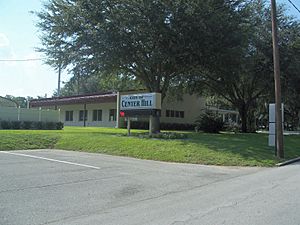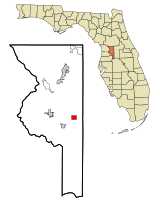Center Hill, Florida facts for kids
Quick facts for kids
City of Center Hill
|
|
|---|---|
| Center Hill, Florida | |

Center Hill City Hall & Police Station
|
|

Location in Sumter County and the U.S. state of Florida
|
|
| Country | |
| State | |
| County | Sumter |
| Settled (Abraham's Old Town) | 1800 |
| Settled (Peliklakaha) | 1813 |
| Founded (Center Hill) |
c. Late 1830s-Early 1840s |
| Incorporated (City of Center Hill) | 1925 |
| Government | |
| • Type | Mayor-Council |
| Area | |
| • Total | 6.45 sq mi (16.70 km2) |
| • Land | 6.10 sq mi (15.80 km2) |
| • Water | 0.35 sq mi (0.90 km2) |
| Elevation | 98 ft (30 m) |
| Population
(2020)
|
|
| • Total | 846 |
| • Density | 138.71/sq mi (53.55/km2) |
| Time zone | UTC-5 (Eastern (EST)) |
| • Summer (DST) | UTC-4 (EDT) |
| ZIP code |
33514
|
| Area code(s) | 352 |
| FIPS code | 12-11325 |
| GNIS feature ID | 0280236 |
| Website | https://www.sumtercountyfl.gov/544/City-of-Center-Hill |
Center Hill is a city located in Sumter County, Florida, in the United States. In 2020, about 846 people lived there. It's a small city with a rich history, especially known for its past connections to Native American and African American communities.
Contents
History of Center Hill
Early Settlements and Peliklakaha
Around the year 1800, a group of people known as Black Seminoles and "maroons" (who were formerly enslaved people who had escaped) settled in the area that is now Center Hill. They called their settlement "Abraham's Old Town". These maroons had fought for England during the American Revolution. After the war, they fled to Florida, which was then controlled by Spain and offered freedom.
The Black Seminoles and maroons lived alongside the Seminoles. They had a special arrangement where the Black Seminoles paid the Seminoles with a part of their crops in exchange for their freedom. In 1813, the Black Seminoles named their town "Peliklakaha". Micanopy, an important Seminole chief, also made Peliklakaha his home.
The town grew to about 100 residents. Many were formerly enslaved people from Georgia. Others came from the Kongo region in Africa. Some Seminoles, including one of Micanopy's wives, also lived there. The town's design showed influences from different cultures. Its buildings were made from materials like mud, thatch, and wood. Peliklakaha was a busy trading center because it was located where several important Native American trails met.
Both the United States and Florida governments noticed how fertile the land was in this area. In 1823, a representative named Horatio S. Dexter found that the Black Seminoles were growing crops like rice, peanuts, and corn. In 1826, General George McCall visited Peliklakaha and described their farms as being on "the finest land."
The Second Seminole War and Its Impact
White settlers often called the town "Abraham's Old Town." This name came from Abraham, a former enslaved person who became an important leader and interpreter for the Seminoles. He helped recruit people to fight and spoke for the Seminoles.
During the Second Seminole War, Abraham learned that U.S. Army soldiers, led by Francis L. Dade, were planning to cross through the area. Abraham believed they would attack Peliklakaha. He convinced Chief Micanopy to move Seminole soldiers to a strategic road. After a major battle known as Dade's Massacre in December 1835, Abraham left the village.
In 1836, U.S. Army General Winfield Scott sent troops to the Peliklakaha area to fight the Seminoles. These troops burned Peliklakaha. However, no Seminoles were killed because the people of Peliklakaha had already escaped to the nearby Wahoo Swamp before the soldiers arrived. A painting showing the burning of Peliklakaha was later created and displayed in the Library of Congress.
Years later, in April 1842, another battle took place near Peliklakaha. Colonel William J. Worth attacked Halleck Tustenuggee and his warriors. The Seminole warriors built a barricade from logs. U.S. Army soldiers attacked from the front, while another group attacked from behind. Halleck Tustenuggee and his warriors eventually retreated, and the U.S. Army burned their camp. A few days later, Halleck Tustenuggee and some of his family surrendered. On August 14, 1842, the Second Seminole War was declared over.
Founding of Center Hill
In the late 1830s and early 1840s, families like the Mobleys and Bevilles began to settle in the area. The town got its name "Center Hill" from either the postmaster, Thomas W. Spicer, or a resident named Carrie Lovell. Spicer thought the town was a central hub of activity. Lovell named it because it was located on a hill in the middle of the county. In 1925, Center Hill officially became an incorporated city.
Farming History
In the early 1900s, Center Hill was famous for growing string beans. Some people even called it the "Green Bean Capitol of the World." In 1931, Center Hill shipped fresh green beans, green peas, and lima beans to big cities like Baltimore, Boston, New York City, Chicago, and Detroit.
However, starting in the mid-1930s, the soil in Center Hill became less fertile. Farmers believed this was because the water levels had dropped. They thought a project from 1922, which drained water from Jumper Creek, was the cause. By 1975, bean farming had almost stopped, and the city's population dropped significantly. Even so, in 1988, farmers in the area still brought other vegetables like bell peppers, cucumbers, squash, tomatoes, and watermelons to Center Hill for packaging and shipping.
Changes in the 1990s
In the 1990s, Center Hill received a special grant to hire more police officers. This grant helped the city increase its police force. Over time, there were some changes in the police department, and the number of officers was adjusted.
Rediscovering Peliklakaha
In 1998, archaeologists from the University of Florida began digging in a field near Center Hill. They were looking for the lost Black Seminole village of Peliklakaha. This was the first time a Black Seminole village was excavated. Researchers wanted to learn about how the people lived and organized their community.
They found many interesting items, including iron pieces, stoneware, glass beads, nails, and pottery. Historians believe that over 100 Black Seminoles lived in Peliklakaha, making it the largest known Black Seminole village. It is also thought that the village was rebuilt after some of the first Seminoles and Black Seminoles were moved to reservations in the west.
Geography
Center Hill is located at 28°38′56″N 81°59′43″W / 28.648869°N 81.995396°W.
The United States Census Bureau reports that the city covers a total area of about 1.8 square miles (4.7 square kilometers). Most of this area is land, with a small portion being water.
Climate
The climate in Center Hill is known for its hot and humid summers. The winters are generally mild. According to the Köppen climate classification system, Center Hill has a humid subtropical climate (Cfa). This means it has warm, wet summers and mild, dry winters.
Population and People
| Historical population | |||
|---|---|---|---|
| Census | Pop. | %± | |
| 1910 | 299 | — | |
| 1920 | 574 | 92.0% | |
| 1930 | 726 | 26.5% | |
| 1940 | 545 | −24.9% | |
| 1950 | 522 | −4.2% | |
| 1960 | 529 | 1.3% | |
| 1970 | 371 | −29.9% | |
| 1980 | 751 | 102.4% | |
| 1990 | 735 | −2.1% | |
| 2000 | 910 | 23.8% | |
| 2010 | 988 | 8.6% | |
| 2020 | 846 | −14.4% | |
| U.S. Decennial Census | |||
Population Changes (2010 and 2020)
The city's population changes over time are recorded in the United States Census. Here's a look at the racial makeup of Center Hill based on the 2010 and 2020 censuses:
| Race | Pop 2010 | Pop 2020 | % 2010 | % 2020 |
|---|---|---|---|---|
| White (NH) | 511 | 405 | 51.72% | 47.87% |
| Black or African American (NH) | 88 | 82 | 8.91% | 9.69% |
| Native American or Alaska Native (NH) | 4 | 1 | 0.40% | 0.12% |
| Asian (NH) | 3 | 2 | 0.30% | 0.24% |
| Pacific Islander or Native Hawaiian (NH) | 0 | 1 | 0.12% | |
| Some other race (NH) | 2 | 14 | 0.20% | 1.65% |
| Two or more races/Multiracial (NH) | 15 | 38 | 1.52% | 4.49% |
| Hispanic or Latino (any race) | 365 | 303 | 36.94% | 35.82% |
| Total | 988 | 846 |
In 2020, there were 846 people living in Center Hill. These people made up 322 households and 212 families. In 2010, the population was 988 people, living in 368 households and 289 families.
Agriculture
Center Hill was once known as the "Green Bean Capitol of the World" because of its large production of string beans. Even today, the area is recognized for its high-quality soil, which is great for farming.
Industry
One of the important industries in Center Hill is Central Beef Industries.
Central Beef Industries
In 2013, the Seminole Tribe started working with Central Beef. They partnered to process beef for the tribe's own "Seminole Pride" brand. Central Beef has worked to meet environmental standards and manage its operations responsibly.
Images for kids
See also
 In Spanish: Center Hill (Florida) para niños
In Spanish: Center Hill (Florida) para niños



